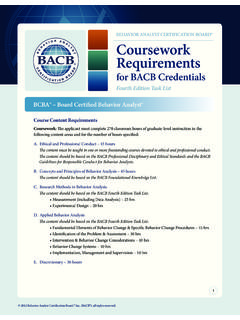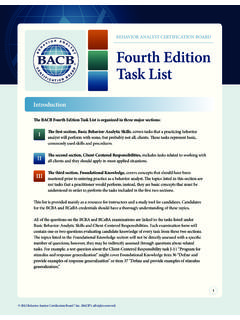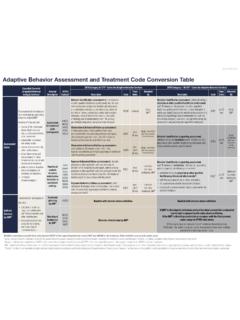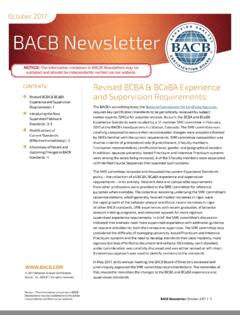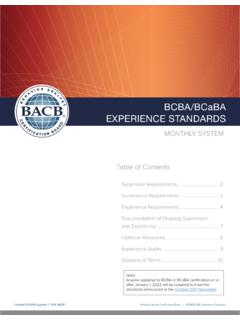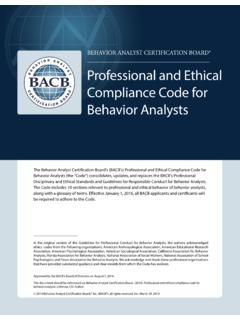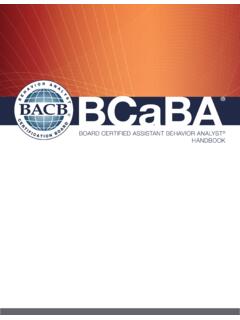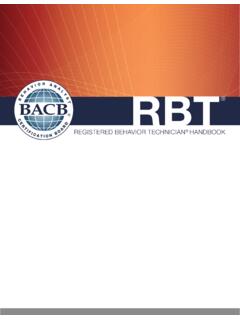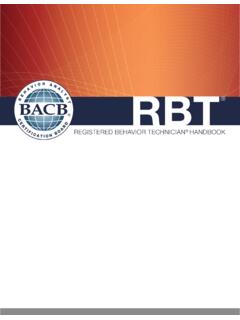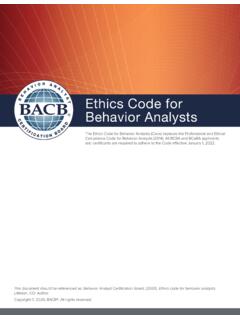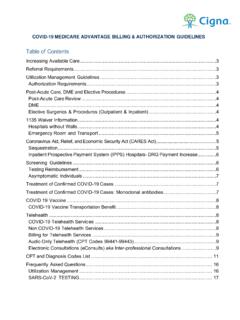Transcription of Applied Behavior Analysis SUBSPECIALTY AREAS
1 Applied Behavior Analysis SUBSPECIALTY AREAS . TABLE OF CONTENTS. BEHAVIORAL TREATMENT OF AUTISM. AND OTHER DEVELOPMENTAL ORGANIZATIONAL Behavior Behavior Analysis IN. BRAIN INJURY BEHAVIORAL CLINICAL Behavior Behavior Analysis IN BEHAVIORAL SPORT PREVENTION AND BEHAVIORAL. INTERVENTION OF CHILD BEHAVIORAL TREATMENT OF. SUBSTANCE USE Behavior Analysis IN. ENVIRONMENTAL Behavior Analysis IN HEALTH AND BEHAVIORAL Version 01/2021. Applied Behavior Analysis | SUBSPECIALTY AREAS . This document provides summaries of many major SUBSPECIALTY AREAS in Applied Behavior Analysis . The content was developed by experts who currently work in these AREAS . BEHAVIORAL TREATMENT OF AUTISM. AND OTHER DEVELOPMENTAL DISABILITIES. Applied Behavior Analysis (ABA) is best known for its success in treating individuals with autism spectrum disorder (ASD) and other developmental disabilities ( , Down syndrome, intellectual disabilities).
2 Treatment in this area is effective across an individual's lifespan ( , childhood, adolescence, adulthood). In young children with developmental disabilities such as ASD, the goal of intensive, comprehensive intervention is to improve cognitive, language, social, and self-help skills. Decades of research have shown that intensive ABA treatment is the most successful approach for children with autism, and it is widely recognized by a number of sources including the Surgeon General, the American Academy of Pediatrics, and the National Institute of Mental Health. When Applied to older individuals, ABA involves teaching behaviors essential to functioning effectively in the home, school, and community. ABA can also decrease severe problem behaviors that endanger health and safety, and limit educational, residential, or vocational options. Concentration AREAS within this SUBSPECIALTY include: focused intervention, intensive and comprehensive intervention for young children, and treatment of severe Behavior problems.
3 Learn More Association for Science in Autism Treatment Applied Behavior Analysis Treatment for Autism Spectrum Disorder: Practice Guidelines for Healthcare Funders and Managers (2nd ed.). Practical Functional Assessment ORGANIZATIONAL Behavior MANAGEMENT. Organizational Behavior Management (OBM) focuses on assessing and changing the work environment to improve employee performance and workplace culture. OBM consultants and managers work in a variety of industries ( , health care, human services, education, government, nonprofits, manufacturing, financial services, retail) to achieve meaningful and sustainable Behavior change and improved business outcomes. OBM practitioners typically facilitate change initiatives, improve and develop processes and systems, close gaps in employee performance, retain and develop staff, and support business growth. Organizational results often include reduced accidents and injuries, improved employee retention, improved customer satisfaction and retention, cultural integration after mergers and acquisitions, improved quality standards, and increased revenue and profits.
4 -2- Applied Behavior Analysis | SUBSPECIALTY AREAS . Concentration AREAS within this SUBSPECIALTY include: performance management, Behavior -based safety, behavioral systems Analysis , consumer Behavior Analysis , health and wellness, monetary incentive systems, training and development, and leadership and culture. Learn More OBM Network Cambridge Center for Behavioral Studies International Society for Performance Improvement Behavior Analysis IN BRAIN INJURY REHABILITATION. Brain injuries can result in lifelong physical, cognitive, and behavioral changes, which can slow progress toward rehabilitation goals and independent living. Behavior analysts add value to interdisciplinary teams for patients with a brain injury by developing both skill-acquisition and Behavior -reduction programs throughout the continuum of care ( , acute, post-acute, long term). Common goals for skill-acquisition programs include improved social interactions and the ability to return to work.
5 Common goals for Behavior -reduction programs include decreased aggression and inappropriate vocalizations. Symptoms following brain injury are highly idiosyncratic, which makes Behavior analysts' use of single- subject designs particularly useful for evaluating rehabilitative outcomes ( , monitoring Behavior following medication changes). Given rising healthcare costs and the reduced availability of rehabilitation services, Behavior analysts' focus on measurement, accountability, and evidence-based treatment makes them integral to a patient's success. Learn More ABA Rehab Special Interest Group Brain Injury Association of America Cambridge Center for Behavioral Studies North American Brain Injury Society Brainline: All About Brain Injury and PTSD. BEHAVIORAL GERONTOLOGY. Behavioral gerontology is the application of Behavior Analysis to age-related issues.
6 By 2030, more than 20% of the population will be over the age of 65, and 1 in 3 seniors will have obesity, depression, diabetes, and/or a neurocognitive disorder, among other conditions. Behavior analysts can work directly with seniors or with care staff to implement sustainable, non-pharmacological supports to enhance quality of life and care services, decrease challenging behaviors, maintain daily life skills, implement memory and language programs, preserve medication adherence, and prolong independence for medical conditions related to aging. -3- Applied Behavior Analysis | SUBSPECIALTY AREAS . Concentration AREAS within this SUBSPECIALTY include: behavioral medicine, health and fitness, mental health, memory problems, and neurocognitive disorders. Learn More Behavioral Gerontology Special Interest Group On Facebook CLINICAL Behavior Analysis . Clinical Behavior Analysis is the application of the conceptual and methodological tools of Behavior Analysis to treat problems that have traditionally been characterized as mental disorders.
7 Clinical Behavior analysts work in universities, hospitals, outpatient clinics, as well as in primary care and residential settings. Common problems addressed through clinical Behavior Analysis include depression, anxiety, stress, relationship discord, substance misuse, chronic pain, disruptive Behavior , impulsivity, inattention, tic disorders, and sleep disturbance, among others. Interventions involve understanding clients' thoughts, feelings, and actions all of which are viewed as Behavior that must be understood in context thereby necessitating descriptive functional analyses of their environmental antecedents (distal and proximate, verbal and nonverbal) and consequences (immediate and delayed, verbal and nonverbal). Common modalities and forms of clinical Behavior Analysis include acceptance and commitment therapy, behavioral activation, behavioral parent training, community reinforcement, comprehensive behavioral intervention for tics, contingency management interventions, dialectical Behavior therapy, functional analytic psychotherapy, integrative behavioral couples therapy, and stimulus control therapy for insomnia.
8 Learn More Clinical Behavior Analysis Special Interest Group Association for Contextual Behavioral Science Behavior Analysis IN EDUCATION. Behavior Analysis has been used to improve teaching and increase learning across content AREAS , grade levels, and student populations for over 60 years. It provides a scientific approach to designing, implementing, and evaluating instruction based on analyzing interactions between what the teacher does and student learning. Behavioral strategies and tactics are used to teach academics, social, vocational, and daily living skills, and to improve entire systems of schooling. Key features include high rates of relevant learner responses with contingent feedback, and ongoing instructional decision-making based on direct and frequent measures of student performance. Behavioral instructional design informs curriculum development from basic academics to concept formation and problem solving.
9 -4- Applied Behavior Analysis | SUBSPECIALTY AREAS . Concentration AREAS within this SUBSPECIALTY include: classroom management, curriculum and instruction, direct instruction, educational technology, evidence-based education, general education, gifted education, mainstream education, special education, instructional design, personalized system of instruction, precision teaching, programmed instruction, school-wide positive Behavior support, systems of schooling (administration, policy), and teacher education. Learn More ABAI Statement on Students' Right to Effective Education Behavior Analysis & Technology ABAI Special Interest Group National Institute for Direct Instruction Schoolwide Positive Behavioral Intervention & Supports Journal of Behavioral Education BEHAVIORAL SPORT PSYCHOLOGY. Behavioral sport psychology focuses on the use of Behavior Analysis concepts, principles, and techniques to enhance the performance and satisfaction of athletes, teams, and coaches.
10 Common goals in the area include teaching new skills; decreasing persistent errors; decreasing problem behaviors; maximizing competition performance; addressing motivation, thinking, emotions, confidence, and concentration related to athletic performance; teaching coaching techniques; and promoting adherence to a healthy diet and regular exercise regime. Common interventions in the area include goal-setting and self-monitoring, self- talk regulation, imagery rehearsal/visualization, video feedback, auditory feedback, behavioral skills training, contingency management, and the development of user-friendly manuals and computer tools for athletes. Behavioral sport psychology frequently involves evaluating interventions using single-subject research designs and placing high value on accountability for everyone involved in the program. Concentration AREAS within this SUBSPECIALTY include: athletic training, behavioral coaching, behavioral sport psychology consultation, personal training, and sports strength and conditioning.
